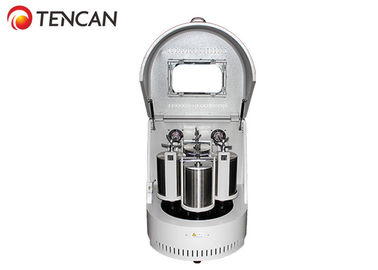In the world of material processing, giants aren’t always the most crucial players. Laboratory ball mills, though smaller in stature compared to their industrial counterparts, play a vital role in research and development. These compact machines are the workhorses of miniaturized grinding, enabling researchers to achieve precise particle size reduction for a wide range of applications. Let’s delve into the world of laboratory ball mills, exploring their functionalities, key components, and the critical parameters that define their operation.

Laboratory ball mills operate on a fundamental principle: grinding through collision and attrition. Here’s a breakdown of the process:
The Grinding Chamber: The heart of the mill is a cylindrical chamber that houses grinding media, typically balls made of ceramic or metal.
The Rotation: The chamber rotates on its horizontal axis, causing the grinding media to tumble and collide with each other and the material being processed.
Particle Size Reduction: As the grinding media collides, the material gets crushed and progressively reduced in size through impact and attrition.typical laboratory ball mill is comprised of several key components:
Drive System: The motor and drive system ensure the grinding chamber rotates at a controlled speed, allowing for precise control over the grinding process.
Grinding Chamber: This cylindrical chamber, often made of high-strength materials like steel or stainless steel, houses the grinding media and the material being processed. Material selection for the chamber depends on the material being processed to avoid contamination.
Grinding Media: The grinding media, usually balls made of ceramic or metal, plays a crucial role in size reduction. The size and material of the grinding media are chosen based on the desired particle size and the properties of the material being processed.
Feeding System: A feeding system allows for the introduction of the material to be processed into the grinding chamber.
Discharge System: A discharge system allows for the removal of the processed material after grinding.While seemingly simple, the operation of a laboratory ball mill is governed by several critical parameters that significantly impact the grinding process and final product:
Mill Speed: The rotational speed of the grinding chamber directly affects the energy imparted to the grinding media and the resulting impact forces. Higher speeds generally lead to faster grinding but can also generate more heat and potentially damage the material being processed.
Grinding Time: The duration of the grinding process significantly influences the final particle size. Longer grinding times result in finer particles, but there's a point of diminishing returns. Over-grinding can lead to unwanted effects like increased surface area and potential changes in the material's properties.
Ball Size and Filling Ratio: The size and volume of the grinding media within the chamber play a crucial role. Smaller grinding media generate greater shear forces, resulting in finer particles. Conversely, larger media are suitable for coarser grinding. The filling ratio, or the percentage of the chamber occupied by grinding media, also affects grinding efficiency. Too little media reduces grinding efficiency, while too much can lead to excessive wear on the media and the chamber itself.
Material Properties: The characteristics of the material being processed, such as its hardness, friability, and moisture content, significantly influence the grinding process. Understanding these properties allows for adjustments in other parameters like mill speed and grinding media selection to achieve the desired outcome.Several factors contribute to the widespread use of laboratory ball mills in research and development settings:
Versatility: These mills can handle a wide range of materials, from soft pharmaceuticals to hard ceramics.
Precise Control: The ability to adjust various parameters allows for precise control over the final particle size and the properties of the ground material.
Scalability: Laboratory ball mills come in various sizes, catering to research needs ranging from small sample volumes for analysis to slightly larger batches for pilot testing.
User-Friendly Operation: Modern laboratory ball mills are designed for ease of use, with intuitive controls and minimal training requirements.
Closed System Operation: Many laboratory ball mills operate as closed systems, minimizing dust generation and ensuring operator safety.Laboratory ball mills are more than just miniaturized grinders; they are powerful tools that empower researchers to achieve precis
